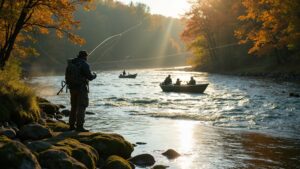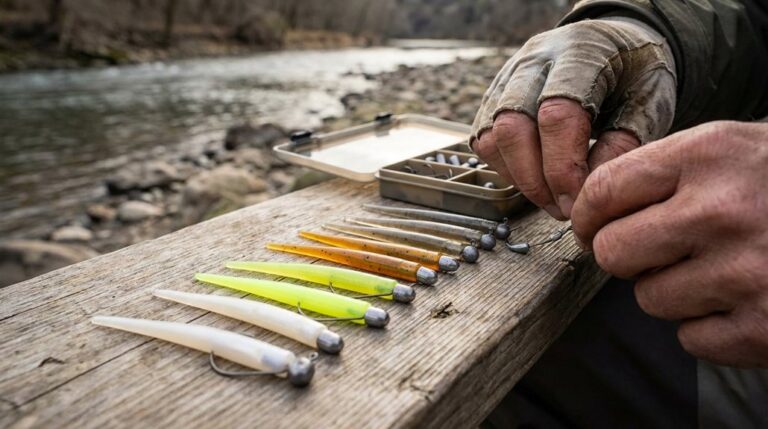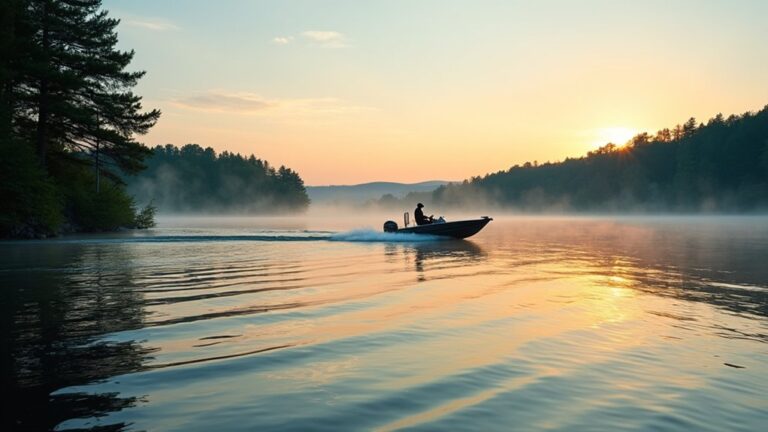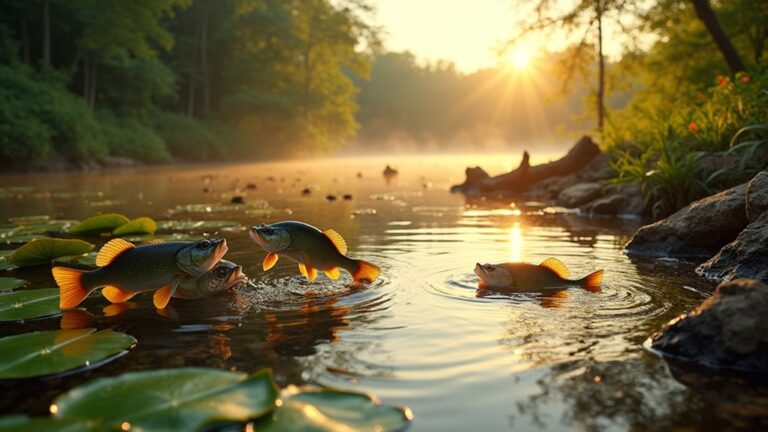You’ll find top river fishing across Massachusetts — try the trout-rich Swift River and Quabbin Reservoir for stocked brook and rainbow trout, the long, varied Deerfield for trophy browns, and the Housatonic (check the Lee catch-and-release) for cold-run trout. The Connecticut offers both trout runs and bass stretches, while the Charles, Millers, and Westfield serve up reliable bass, panfish, and wild trout. Keep going and you’ll get access points, tactics, and hatch tips.
Important Takeaways
- Deerfield River: long, scenic 76-mile fishery with stocked and wild trout, shore access, kayak launches, and hatch-driven fly fishing.
- Housatonic River (Lee C‑and‑R): reliable trout runs near Sheffield with public wading, nymphs and streamers highly effective.
- Connecticut River: expansive 400+ mile system offering trout cold runs, bass in slower stretches, many public launch and shore spots.
- Swift River/Quabbin Reservoir area: trout-stocked East/West/Middle Swift and Quabbin’s 39 sq mi waters; shore and boat access for catch‑and‑release fly anglers.
- Millers, Westfield, and Charles Rivers: Millers and Westfield for trout in rural stretches; Charles River for urban warm‑water species and easy access.
Swift River and Quabbin Reservoir
Looking for top trout and bass fishing in Massachusetts? You’ll find the Swift River and Quabbin Reservoir deliver. The Swift River (East, West, Middle) is stocked annually and popular for trout fly fishing; you’ll target stocked brook trout and rainbow trout using Brassy, Crystal Midge, or Zebra Midge patterns.
Quabbin Reservoir spans 39 square miles, offers both trout and bass, and runs seasonally April 16–October 15 with multiple access points for shore and boat fishing.
Shoreline access and designated access points on the Swift make catch-and-release easy and focused for fly anglers.
Pack flies suited to each waterbody, scout access points ahead of time, and follow regulations to preserve trout populations and quality fishing at both locations.
Early mornings and late afternoons are often the best times to fish, especially near inlets and estuaries where feeding activity concentrates.
Deerfield River
While the Swift River and Quabbin offer stocked trout and reservoir bass, head west to the Deerfield River for a longer, more varied trout experience. You’ll find 76 miles through western Massachusetts where trout fishing shines: stocked brown trout, brook trout and rainbow trout mix with wild fish, giving real trophy potential in some stretches. Public access points and private sections let you choose shore fishing or launch a kayak. Fly fishing pays off during hatches, though spoons and spinners work too. Scenic banks and year-round opportunity make it a must-visit in Franklin County.
| Species | Access | Best Method |
|---|---|---|
| Brown, Brook | Public access | Fly fishing |
| Rainbow | Shore fishing | Spin/flies |
Housatonic River (Including Lee Catch-And-Release Area)
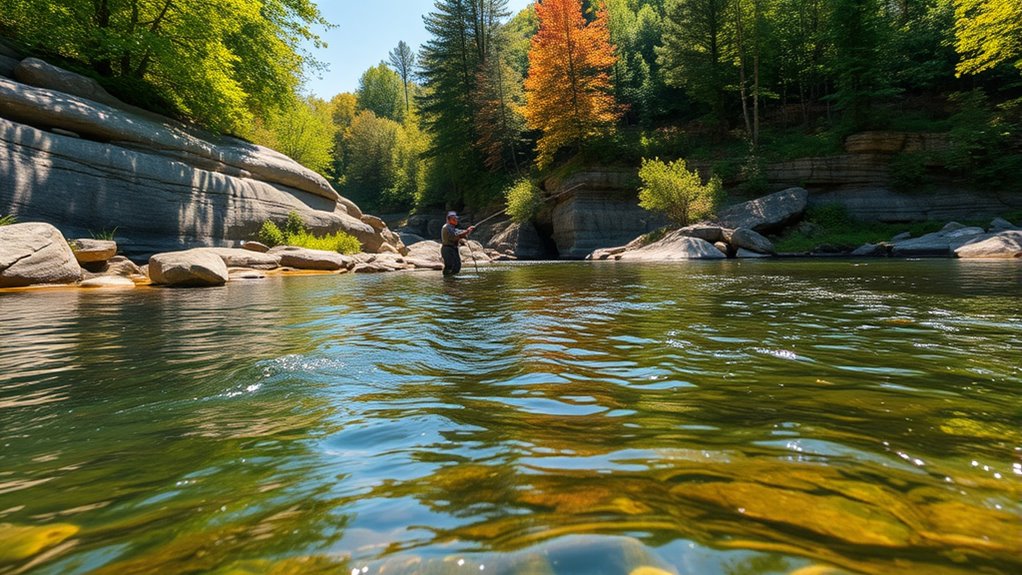
Wondering where to find steady trout action in western Massachusetts? Head to the Housatonic River near Sheffield, where public access points and bridges make shore fishing and wading easy. You’ll find stocked trout alongside wild brown trout, rainbow trout, and brook trout holding in cold runs and pocket water.
The Lee catch-and-release section keeps fish abundant and encourages top-quality trout fishing, especially if you practice careful handling. You’ll do well with fly fishing—nymphs and streamers work—while spin anglers land steady returns with small spoons and spinners.
Seasonal flows and accessible reaches offer year-round opportunity, so plan your visit around water and weather, respect public access rules, and enjoy consistent coldwater action. Topwater techniques can still be effective in low, warm stretches when bass move to the surface and respond to walking baits.
Connecticut River
The Connecticut River, New England’s longest waterway at about 406 miles, gives Massachusetts anglers a wide mix of fishing opportunities—from trout-holding cold runs to bass and perch in slower stretches—accessible from numerous public launch points and shore spots. You’ll find shore fishing and boat access at public access points that put you into stocked/ wild trout water, or slower pools for bass and perch. For fly fishing try Elk Hair Caddis or Muddler Minnow in cooler flows; nymphs like Flashback Pheasant Tail work too. This river basin offers varied fishing spots across states, rewarding both sight-casting anglers and those chasing stocked trout. Coral reefs host vibrant species like clownfish and angelfish with complex social structures.
| Quiet dawn | Rushing riffle |
|---|---|
| Heart calm | Line tight |
Charles River
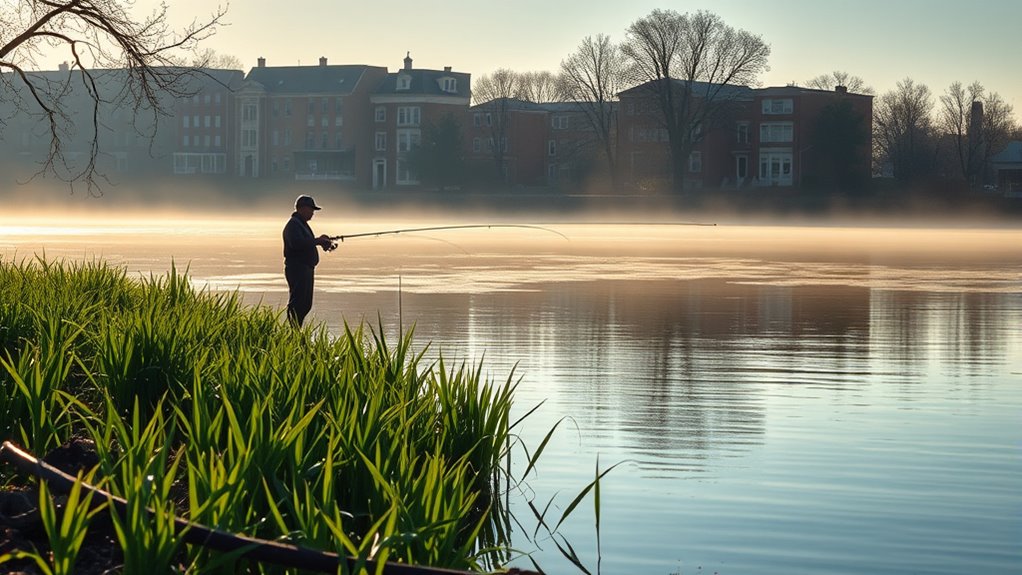
Looking for an easy-to-reach river that mixes urban scenery with solid warm-water fishing? You’ll find the Charles River offers about 80 miles of varied water and plenty of public access. You can try shore fishing from public banks, cast from bridges, or launch watercraft like kayaks and canoes at marked access points. Urban fishing sections near Boston give quick walks to productive spots, while upstream reaches feel more natural.
Expect largemouth bass, bluegill, yellow perch and redfin pickerel, with peak activity in warm-water periods and insect hatches that trigger bites. Check town-specific rules and NRD guidelines before you go, since access and conditions change by municipality and season. Always wear a properly fitting PFD when fishing from a kayak or canoe to stay safe on the water and comply with safety recommendations.
Millers River
Why not try the Millers River for a mix of trout fishing and easy access? You’ll find a 52.1-mile corridor in Massachusetts from Ashburnham to Millers Falls, with a popular fly fishing stretch between South Ralston bridge and Starrett Factory Dam near Athol. The river holds stocked and wild brown, brook, and rainbow trout, so you can practice catch-and-release or traditional angling. Public access points and bridges give you plenty of shore-fishing spots, and wading opportunities let you reach riffles and runs. Focus on fly fishing with nymphs early and dry flies during hatches, though small spinning lures and bait work when conditions demand. Sections range from urban-adjacent to remote, offering varied experiences. Many anglers also appreciate nearby marinas and bait shops that support longer outings and local knowledge from charter captains and guides familiar with delta ecosystems.
Westfield River
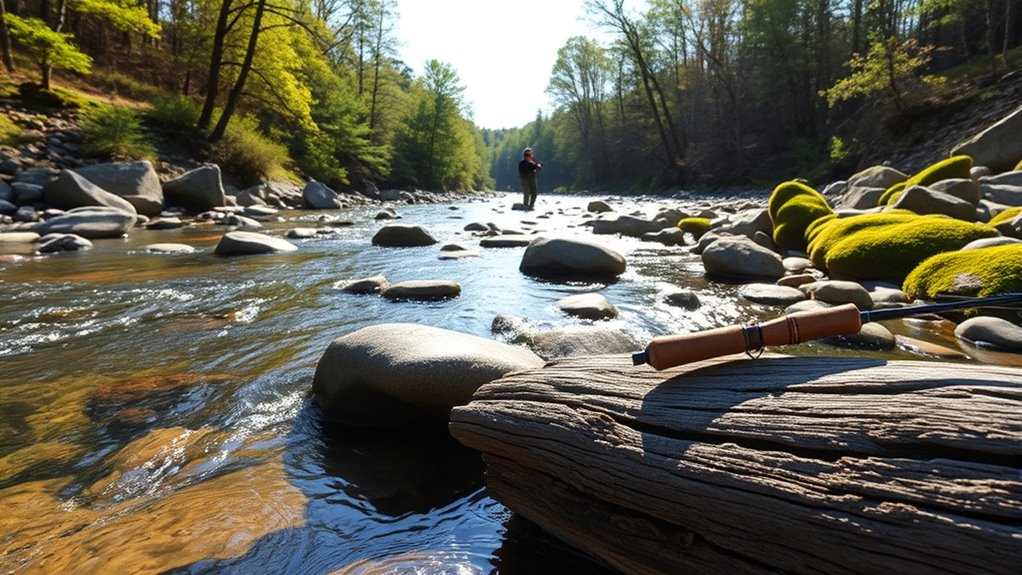
Winding through the Berkshire Mountains, the Westfield River offers trout anglers scenic runs rich with brown, brook, and rainbow trout and plenty of public access for shore fishing and wading. You’ll find access points spaced along the banks, so you can pick a quiet wade or set up for shore fishing where current and structure concentrate fish. Both fly fishing and bait casting are allowed, and you can switch methods depending on water and mood. Anglers commonly use artificial lures, minnows, soft plastics, garden worms, and night crawlers to entice brown trout, rainbow trout, and brook trout. The river’s scenic character and varied habitat make it a reliable western Massachusetts destination when you want versatile trout fishing. San Diego waters host over 100 fish species, including Yellowtail and Giant Tuna, providing diverse fishing experiences year-round.
Final Thoughts
You’ve got great options across Massachusetts — from Quabbin’s deep waters to the trout-rich Deerfield and the fly-fishing seams of the Housatonic, Connecticut, Charles, Millers, and Westfield rivers. Pack waders, check local regs and seasonal runs, and focus on current breaks, riffles, and shaded undercuts where fish hide. Try different lures, present naturally, and be ready to move spots if the bite’s slow. Respect habitats, practice catch-and-release when appropriate, and enjoy the river rhythm.

